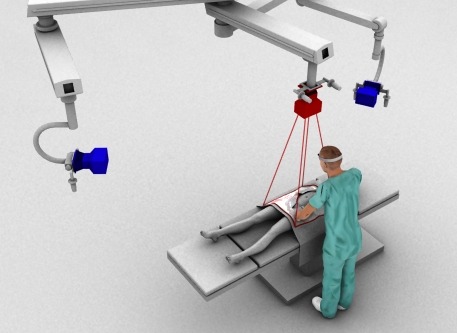Medical Augumented Reality Visualizator


The aim of the project is a research on applicability of augmented reality in surgical procedures for improved navigation efficacy and spatial orientation tasks. State of the art surgical procedures and operating theatres depend mostly on surgeon’s expertise. While procedures performed with a help of modern navigation and visualization aids are encumbered with necessity to use 3D goggles or computer screens located in the operating room. Wearing 3D goggles results in difficulties with spatial perception and rapid eye fatigue, headaches and substantial discomfort. Application of external screens requires the surgeon to often change his focus from a patient to a screen and vice-versa, what extends the duration the operation. The main research hypothesis that will be answered by the project may be expressed as: “Application of augmented reality techniques will increase effectiveness of surgical procedures on the liver in comparison to currently applied solutions.” It will be realized by surgeon’s natural visual perception enhanced with parallax compensated projection of 2D or 3D image on the surface of the liver (rendered from the surgeon’s point of view).
Research project methodology
Research methods differ in the first and the second phase of project realization. In the first phase, a set of virtual environments for analysing human perception will be prepared and parameters of liver phantom will be analysed. Virtual reality environments will be used to realize simulation tasks. Core feature of these virtual environments will be simulation set-up for tracking and image projection. After development of the simulation environments, the tests will be carried out on two groups of users to assess perceptiveness of selected stage elements and ability to locate them with a tool depending on presentation methods. A test on both experienced surgeons and, independently, surgery students groups are planned. Thus, developed environments will be presenting typical diagnostic or surgical intervention scenarios (at least 6 scenarios).
In the next stage of the project, liver phantoms (with application of 3D printing technique) and interactive 3D segmentation algorithms employing expert knowledge for quick and reliable segmentation will be developed. At this stage, a set-up for realization of final user-tests along with necessary algorithms (implemented in C++ programming language) will be developed and realized in actual operation theatre for allowing test conditions closest to natural. After the tests on phantoms, a research will be carried out on 20 porcine livers, with assessment of time required for successful location of a target, number of attempts needed to hit the target, and questionnaire on subjective participant’s sensations (including side effects) while working with augmented reality.
Expected impact of the research project on the development of science, civilization and society
The research in the project will allow for better application of visualization techniques for assisting surgeons by: using natural human visual perception without need to adapt to artificial stereoscopic visualization (no depth of field and convergence of stereo-images control) or need to change observation focus from patient to computer screen by projection on the surface of inspected organ its internal structures. This kind of approach allows increased surgeon effectiveness and will contribute to minimization of surgery times, number of perioperative and postoperative complications and also improved surgical effectiveness in general. The studies of the project are interdisciplinary, combine informatics, virtual and augmented reality techniques, and medicine in the field of general, oncological and transplantation surgery of the liver. Realisation of real-time algorithms in the operating theatre as well as semi-automated liver segmentation algorithms are a challenging IT endeavour. In the field of virtual and augmented reality, issues referring to human-machine interface are forward-looking in terms of anatomical structure imaging, which will allow for correct and prompt perception of the spatial images, assessed as correct location with surgical tool of the target hidden within a 3-dimensional model of the organ. In the field of medicine, studies aimed at precise localization of a lesion with virtual navigation, and minimally invasive, yet no less effective than conventional image-guided surgical intervention enjoy a dynamic boom. Developing effective methods of assisting the surgeon during the operation is not to be underestimated in terms of the development of civilization.

